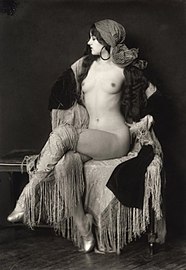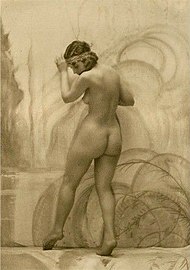Nude photography

Nude photography is the creation of any
The exhibition or publication of nude photographs may be controversial, more so in some cultures and countries than in others, and especially if the subject or viewer is a minor.
Educational
Nude photographs may be used for scientific and educational purpose, such as ethnographic studies, human physiology or sex education. In this context, the emphasis of the photograph is not on the subject, or the beauty or eroticism of the image, but on the educational or demonstrative purpose for which the image was produced.
The nude image may be used for analysis or to accompany medical or other text books, scientific reports, articles or research papers.[1] They are essentially of an illustrative nature, and so nude photographs of this type are often labeled to show key features in a supporting context.
Commercial
Erotic
Since the first days of photography, the nude was a source of inspiration for those that adopted the new medium. Most of the early images were closely guarded or surreptitiously circulated as violations of the social norms of the time, since the photograph captures real nudity. Many cultures, while accepting nudity in art, shun actual nudity. For example, even an art gallery which exhibits nude paintings will typically not accept nudity in a visitor.
-
Ziegfeld Follies showgirl Dorothy Flood by Johnston
-
Unidentified model by Johnston
-
Follies Bergere showgirl by Stanisław Julian Ignacy Ostroróg
-
Unidentified nude model kneeling with an open umbrella obscuring her torso
Glamour

Glamour photographs emphasize the subject, usually female, in a
Advertising
Nudity and sexually suggestive imagery is common in modern-day culture and widely used in advertising to help sell products. A feature of this form of advertising is that the imagery used typically has no connection to the product being advertised. The purpose of such imagery is to attract the attention of a potential customer or user. The imagery used may include nudity, actual or suggestive, and glamour photography.
Entertainment
Nude or semi-nude imagery is also widely used in entertainment, sometimes referred to as adult entertainment. This may be in the form of
Covers of mainstream magazines sometimes include images of nude or semi-nude subjects. In the early 1990s,
Music album covers
Music album covers often incorporate photography, at times including nude or semi-nude images. Album covers that have incorporated nudity have included those of performers such as Jimi Hendrix (Electric Ladyland, 1968), John Lennon and Yoko Ono (Unfinished Music No. 1: Two Virgins, 1968), Nirvana, Blind Faith (Blind Faith, 1969), Scorpions (Virgin Killer, 1976) and Jane's Addiction (Nothing's Shocking, 1988). The covers for Blind Faith and Virgin Killer were especially controversial because the nude images were of prepubescent girls, and were re-issued with alternative covers in some countries.
Fine art
The emphasis of
History
- Durieu/Delacroix
-
Photograph by Jean Louis Marie Eugène Durieu, part of a series made with Eugène Delacroix
-
Odalisque (1857) by Eugène Delacroix, a painting with similar pose
-
Photograph by Jean Louis Marie Eugène Durieu, c. 1855
19th century
Early fine-art photographers in
- Historical images
-
Nude by Gaudenzio Marconi, 19th century
-
Nude by Gaudenzio Marconi, 1841–1885
Modern

After
Contemporary
The distinction between fine art and glamour is often one of marketing, with fine art being sold through galleries or dealers in limited editions signed by the artist, and glamour photos being distributed through mass media. For some, the difference is in the gaze of the model; glamour models look into the camera, while art models do not.[15] Glamour and fashion photographers have aspired to fine-art status in some of their work. One such photographer was Irving Penn, who progressed from Vogue magazine to photographing fashion models such as Kate Moss nude. Richard Avedon, Helmut Newton and Annie Leibovitz[16] have followed a similar path with portraits of the famous, many of them nude[17] or partially clothed.[18] In the post-modern era, where fame is often the subject of fine art,[19] Avedon's photo of Nastassja Kinski with a python, and Leibovitz's magazine covers of Demi Moore pregnant and in body paint have become iconic. The work of Joyce Tenneson has gone the other way, from fine art with a unique, soft-focus style showing women at all stages of life to portraiture of famous people and fashion photography.
Although nude photographers have largely worked within established forms that show bodies as sculptural abstractions, some, such as Robert Mapplethorpe, have created works that deliberately blur the boundaries between erotica and art.
Several photographers have become controversial because of their nude photographs of underage subjects.[20] David Hamilton often used erotic themes.[21][22][23] Sally Mann was raised in rural Virginia, in a locale where skinny-dipping in a river was common, so many of her most famous photographs are of her own children swimming in the nude.[24] Less well-known photographers have been charged as criminals for photos of their own children.[25]
Body image has become a topic explored by many photographers working with models whose bodies do not conform to the largely universal perceptions of beauty.[26]
See also
- Nude photography (art)
- Nude (art)
- Depictions of nudity
- Fine-art photography
- Glamour photography
- Erotic photography model
References
- ^ "Scientific Photographer". Creative Skillset. Archived from the original on December 29, 2012. Retrieved January 6, 2013.
- ^ Yoder, Brian K. "Nudity in Art: A Virtue or Vice?". Archived from the original on 7 April 2022. Retrieved 6 April 2018.
- ^ Hudovernik, Robert (2006). Jazz Age Beauties: The Lost Collection of Ziegfeld Photographer Alfred Cheney Johnston. New York: Universe Publishing/Rizzoli International Publications. p. 272.
- ISBN 0-691-01788-3.
- ^ Rosenthal, Karin. "About My Work". Archived from the original on May 25, 2021. Retrieved December 11, 2012.
- ^ Schiesser, Jody. "Silverbeauty - Artist Statement". Archived from the original on May 25, 2021. Retrieved December 11, 2012.
- ^ Mok, Marcus. "Artist's Statement". Archived from the original on December 27, 2019. Retrieved December 11, 2012.
- ^ a b c "Naked before the Camera". Metropolitan Museum of Art. Archived from the original on 2021-04-12. Retrieved 2012-10-26.
- ISBN 0262231379.
- ^ "Nude Photography Guide". 30 January 2020. Archived from the original on 1 August 2021. Retrieved 29 June 2020. Monday, June 29, 2020
- ISBN 0714845736.
- ISBN 0821224387.
- ^ "Edward Weston Photographs". Center for Creative Photography at the University of Arizona Libraries. Archived from the original on 2010-07-25.
- ^ "Nude photo of Madonna goes for $37,500". CNN. February 12, 2009. Archived from the original on November 17, 2018. Retrieved April 10, 2013.
- ^ Conrad, Donna (2000), A Conversation with Ruth Bernhard, vol. 1, PhotoVision, archived from the original on 2011-07-15, retrieved 2008-11-23
- ^ "Exhibitions: Annie Leibovitz: A Photographer's Life, 1990–2005". The Brooklyn Museum. Archived from the original on 17 April 2022. Retrieved 10 November 2012.
- ^ Jones, Jonathan (8 February 2006). "Not naked but nude". The Guardian. London. Archived from the original on 6 November 2021. Retrieved 12 November 2012.
- ^ "Miley Knows Best". Vanity Fair. 2008. Archived from the original on 25 November 2009. Retrieved 11 November 2012.
- ^ Needham, Alex (22 February 2012). "Andy Warhol's legacy lives on in the factory of fame". The Guardian. London. Archived from the original on 14 July 2022. Retrieved 1 November 2012.
- ^ "Photo Flap". Reason. 1998. Archived from the original on 12 April 2019. Retrieved 11 November 2012.
- ISBN 1854103040.
- ^ Sturges, Jock; Phillips, Jayne Anne (1991). The Last Day of Summer. Aperture.
- ISBN 0893815950.
- ISBN 0893815233.
- ISBN 978-1595585516.
- ^ "Leonard Nimoy: The Full Body Project". R.Michelson Galleries. Archived from the original on 4 October 2012. Retrieved 11 November 2012.
Further reading
- Benjamin, Louis (2009). The Naked and the Lens: A Guide to Nude Photography. Focal Press. ISBN 978-0240811598.
- Booth, Alvin; Cotton, Charlotte, eds. (1999). Corpus: Beyond the Body. Edition Stemmle. ISBN 3908161940.
- Dawes, Richard, ed. (1984). John Hedgecoe's Nude Photography. New York: Simon and Schuster.
- De Dienes, André (2005). Studies of the Female Nude. Twin Palms Publishers. ISBN 1931885443.
- Dennis, Kelly (2009). Art/Porn: A History of Seeing and Touching. Berg. ISBN 978-1847880673.
- Gibson, Ralph (2018). Ralph Gibson. Nude. ISBN 978-3836568883.
- Lynch, David (2018). David Lynch, Nudes. Thames & Hudson. ISBN 978-2869251397.
- Glauso, Leonardo (2019). Nude book. Leonardo Glauso. Blurb. ISBN 978-1518460432.
- Lewinski, Jorge (1987). The naked and the nude: a history of the nude in photographs, 1839 to the present. Harmony Books. ISBN 0517566834.
- Sullivan, Constance, ed. (1980). Nude: Photographs 1850-1980. Harper & Row. ISBN 9780060127084.
- Padva, Gilad. Nostalgic Physique: Displaying Foucauldian Muscles and Celebrating the Male Body in Beefcake. In Padva, Gilad, Queer Nostalgia in Cinema and Pop Culture, pp. 35–57 (Palgrave Macmillan, 2014, ISBN 978-1-137-26633-0).
External links
 Media related to Nude photographs at Wikimedia Commons
Media related to Nude photographs at Wikimedia Commons

















